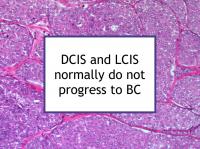Ductal carcinoma in situ (DCIS) and lobular carcinoma in situ (LCIS) are both associated with increased risk of developing invasive breast cancer. DCIS is classified as non-invasive because the cancer cells are confined to milk ducts and have not spread beyond the duct walls to invade the surrounding tissue.
Women with LCIS or atypical lobular hyperplasia (a possible precursor of both LCIS and invasive breast cancer) are at significantly higher than average risk for invasive breast cancer, but the risk is higher for developing both ductal or lobular breast cancer. Significant risk of relapse or progression remains for many years after treatment for DCIS patients. LCIS patients also remain at elevated risk for invasive breast cancer after treatment. Now a new study has estimated the risk of developing invasive breast cancer to be approximately 20% during the first 20 years after a diagnosis of in situ disease.
Latest research finds risk of invasive breast cancer is limited
The nested case control study referenced at the beginning of this news story was designed to estimate the likelihood of developing invasive breast cancer following a diagnosis of carcinoma in situ (DCIS or LCIS). The study used 25-year prospective data from the Canadian National Breast Screening Study (CNBSS), as well as cancer registries and a national vital statistics database.
A total of 146 women were diagnosed with DCIS or LCIS during the study period, of whom 26 (17.8%) developed invasive breast cancer and 12 (8.2%) died of breast cancer. The time from diagnosis of DCIS or LCIS to diagnosis of invasive breast cancer was 6.3 years, on average. The 20-year cumulative risk of invasive breast cancer was 19.0% for DCIS patients and 21.3% for LCIS patients, more than two and one-half times the risk of the healthy women who served as controls. Nevertheless, 20 years after diagnosis, more than 80% of the women diagnosed with DCIS or LCIS remained free of invasive breast cancer. The authors conclude that in situ disease does not always eventually lead to the development of invasive breast cancer.
